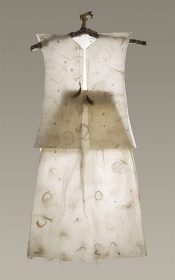Ghetto Life and Beautiful Shoes

Wei Zhang looking at shoes “made in China”, which are part of the Jewish Museum Berlin’s collection; permanent loan by Marion Schubert, née Salomon; Jewish Museum Berlin, photo: Christoph Kreutzmüller
As a student studying the Holocaust at the University of Haifa, I was honored to do a short-term internship at the Jewish Museum Berlin with the team working on the new permanent exhibition. Before it began, I came across a small passage in the book Jewish Responses to Persecution: 1938–1940 (ed. by Jürgen Matthäus, Alexandra Garbarini, Plymouth: AltaMira Press, 2010) written in late 1938, directly after the November pogroms, that illustrated the desperation of German Jews (especially those in Berlin):
“There is one Jewish café open in Berlin. Anyone who wants to see what likely suicides look like should enter this café. The conversation of people sitting there revolves round two topics: how to obtain a passage to Shanghai or how to commit suicide.”
A question came to my mind: Could I find something related to Shanghai, the city where about 20,000 Ashkenazi Jews found refuge, here? As I started my research in the museum’s collection, I was excited to find an abundance of such information. Now I would like to share these stories with you. → continue reading
Readers of our blog may be interested to learn that from 5 May to 3 September, the Museum in the Kulturbrauerei is hosting the exhibition Shalom. 3 Photographers Look at Germany. Holger Biermann | Rafael Herlich | Benyamin Reich. Here is a snippet from the exhibition announcement:
A kosher food store in Berlin, a rabbi’s family with a new-born, police officers standing guard at a Frankfurt synagogue – scenes from everyday Jewish life in Germany. These photographs by Holger Biermann, Rafael Herlich and Benyamin Reich from 2000 to 2015 document Jewish life and culture from different perspectives – not only showing children in a Talmud School or practicing Jews celebrating Rosh Hashanah, the Jewish New Year, but also anti- Semitic graffiti daubed on a synagogue.
The exhibition encourages visitors to engage with the question: How far is Jewish life taken for granted as a normal part of German society 70 years after the Shoah?
Opening times: Tues-Sun 10 am–6 pm, Thurs 10 am–8 pm
Free admission
More information, on supplementary offerings for example, can be found on the website of the Museum in the Kulturbrauerei (in German).
Artist Andi Arnovitz Questions Traditional Matrimonial Law

The Dress of the Unfaithful Wife by Andi LaVine Arnovitz, 2009; photo: Avshlom Avital
In our current exhibition, Cherchez la femme, a transparent dress seems to reveal everything. The Israeli-American artist Andi LaVine Arnovitz created a delicate work of art from washi paper, hair, and Hebrew letters. Locks of hair adorn the paper dress, hinting at the beauty of its wearer. But how to interpret the other components, the grime and coarse body hair?
The individually placed letters are the key to understanding this piece. They point to the biblical ritual described in the Torah, Numbers 5: 11–31, on which this work is based: → continue reading

